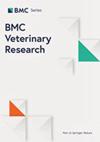Impact of sample refrigeration and freezing on the bacteriological counts of different bedding materials for dairy cows
IF 2.3
2区 农林科学
Q1 VETERINARY SCIENCES
引用次数: 0
Abstract
Different organic and inorganic bedding materials can be used in dairy farms. Among organic materials, there is an increasing interest in alternative substrates based on recycled manure solids (RMS). Microbiological analyses are crucial to monitor the microbial load and evaluate the presence of pathogens impacting animal welfare and health. However, logistic factors may hamper the possibility of immediately sending fresh samples to the laboratory, requiring storage in cooled conditions before analysis. We assessed the impact of sample refrigeration and freezing of different organic and inorganic bedding substrates including separated raw manure solids (SRMS), anaerobically digested manure solids (ADMS), and new sand (NS), on the total bacterial count (TBC) and on different microbial classes. The TBC was higher in fresh NS and ADMS than in refrigerated and frozen samples of the same substrates; in addition, the TBC of ADMS was higher in refrigerated than frozen samples. The TBC of SRMS did not change significantly with refrigeration and freezing. Freezing reduced the total Gram-negative bacterial count more than refrigeration in all substrates. In fresh NS, Gram-negatives were higher than in both refrigerated and frozen NS. Escherichia coli counts were significantly lower in frozen than in refrigerated SRMS. However, both refrigeration and freezing of ADMS resulted in no E. coli growth. The coliform counts were also lower in frozen than refrigerated NS and SRMS. Frozen NS and ADMS showed lower counts compared to refrigeration for Gram-negative bacteria other than E. coli and coliforms. On the other hand, cold storage did not significantly impact the streptococci and streptococcus-like organisms (SSLO) count of all evaluated bedding substrates. Refrigeration and freezing affect the bacteriological results of bedding substrates, with freezing generally leading to lower counts than refrigeration. Whenever possible, preference should be given to analyzing fresh bedding samples, however, when necessary, refrigeration would be recommended over freezing, while acknowledging that the measured bacterial load might underestimate the actual microbial content.样品冷藏和冷冻对不同奶牛垫料细菌计数的影响
奶牛场可使用不同的有机和无机垫料。在有机材料中,人们对基于回收粪便固体(RMS)的替代基质越来越感兴趣。微生物分析对于监测微生物负荷和评估是否存在影响动物福利和健康的病原体至关重要。然而,物流因素可能会阻碍将新鲜样本立即送往实验室的可能性,这就要求在分析前将样本储存在低温条件下。我们评估了不同有机和无机垫料基质(包括分离生粪固体(SRMS)、厌氧消化粪便固体(ADMS)和新砂(NS))的样品冷藏和冷冻对细菌总数(TBC)和不同微生物类别的影响。新鲜 NS 和 ADMS 的细菌总数高于冷藏和冷冻的相同基质样本;此外,冷藏样本中 ADMS 的细菌总数高于冷冻样本。SRMS 的总菌落总数在冷藏和冷冻后变化不大。在所有基质中,冷冻比冷藏更能减少革兰氏阴性菌总数。新鲜 NS 中的革兰氏阴性菌数量高于冷藏和冷冻的 NS。冷冻的 SRMS 中大肠杆菌数量明显低于冷藏的 SRMS。不过,冷藏和冷冻 ADMS 都不会导致大肠杆菌生长。冷冻的 NS 和 SRMS 中的大肠菌群数量也低于冷藏的 NS 和 SRMS。与冷藏相比,冷冻的 NS 和 ADMS 中除大肠杆菌和大肠菌群外的革兰氏阴性菌数量更少。另一方面,冷藏对所有评估过的垫料基质的链球菌和类链球菌(SSLO)数量没有明显影响。冷藏和冷冻会影响垫料基质的细菌学结果,冷冻通常比冷藏导致更低的计数。在可能的情况下,应优先分析新鲜的垫料样本,但在必要的情况下,建议冷藏而不是冷冻,同时也承认测量的细菌量可能会低估实际的微生物含量。
本文章由计算机程序翻译,如有差异,请以英文原文为准。
求助全文
约1分钟内获得全文
求助全文
来源期刊

BMC Veterinary Research
VETERINARY SCIENCES-
CiteScore
4.80
自引率
3.80%
发文量
420
审稿时长
3-6 weeks
期刊介绍:
BMC Veterinary Research is an open access, peer-reviewed journal that considers articles on all aspects of veterinary science and medicine, including the epidemiology, diagnosis, prevention and treatment of medical conditions of domestic, companion, farm and wild animals, as well as the biomedical processes that underlie their health.
 求助内容:
求助内容: 应助结果提醒方式:
应助结果提醒方式:


